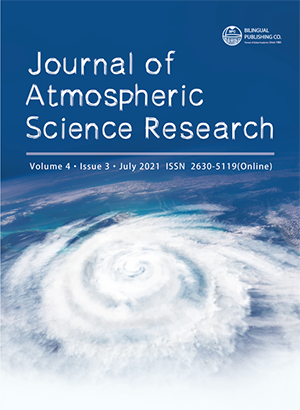-
877
-
400
-
358
-
355
-
339
An Exigency for Ice Core Studies to Determine Spatio-temporal Variability in Moisture Sources and Impact of Black Carbon – Mineral Aerosols on the Himalayan Glaciers
DOI:
https://doi.org/10.30564/jasr.v4i3.3556Abstract
Himalayan glaciers‒ the store house of fresh water outside the polar region contributes ~45% of the total river flow by glacial melt in the Indus, Ganga and Brahmaputra watersheds which supports the livelihood of ~500 million people . The sustainability of these rivers is being questioned because of the growing evidences of accelerated glacier retreat in the recent decades, which is expected to have cascading effects on the mountainous areas and their surrounding lowlands. The rapid melting of Himalayan glaciers reveals their sensitivity to ongoing changes in climate dynamics, and if the current trend continues, rivers that rely heavily on snow/ice melt are expected to suffer hydrological disruptions to the point where some of the most populous areas may ‘run out of water’ during the dry season. Therefore, efforts are being made to study the glacier mass balance trends in order to understand the patterns and causes of recent recessional trend. Despite their importance, the absence of long-term mass-balance and remote sensing data restricts our knowledge of the Himalayan glaciers’ sensitivity/ response to climate change. Furthermore, such studies may be insufficient unless are compared to long-term glacier fluctuations (millennial and multi-millennial time scales), which aid in better understanding the natural trends of and human impacts on climate change, as well as assessing the causes and possible future of contemporary shrinking glaciers. This will also improve our understanding of past glacier behaviour in the context of primary causes of glacier change, which is critical for water resource management and understanding climate variability in high alpine areas where alternative proxy climate archives are typically scarce. Therefore, it is pertinent to pool our scientific resources and energy (i) towards understanding the Himalayan glaciers’ feeders (precipitation sources) and how they changed over time (geological and historical), as well as the causes of glaciers recession, one of which has been identified as (ii) black soot (carbon) in aerosol pollution.References
[1] World Resources Institute – WRI Annual Report (2003). https://www.wri.org/wri-annual-report-2003.
[2] Bolch, T., Kulkarni, A., Kääb, A., Huggel, C., Paul, F., Cogley, J.G., Frey, H., Kargel, J.S., Fujita, K., Scheel, M. and Bajracharya, S., 2012. The state and fate of Himalayan glaciers. Science, 336(6079), pp.310-314.
[3] Maurer, J.M., Schaefer, J.M., Rupper, S. and Corley, A., 2019. Acceleration of ice loss across the Himalayas over the past 40 years. Science advances, 5(6), p.eaav7266.
[4] Riehl, H., 1979. Climate and weather in the tropics; Academic Press, San Diego.
[5] Gadgil, S., 2003. The Indian monsoon and its variability. Annual Review of Earth and Planetary Sciences, 31(1), pp.429-467.
[6] Webster, P.J., 1987, The elementary monsoon; In: Monsoons (eds) Fein, J.S. and Stephens, P.S., 3–32, (New York: Wiley).
[7] Tada, R., Zheng, H. and Clift, P.D., 2016. Evolution and variability of Asian monsoon and its potential linkage with the Himalayas-Tibetan Plateau uplift. Progress in Earth and Planetary Science, 3.
[8] Wu, Z., Li, J., Jiang, Z. and Ma, T., 2012. Modulation of the Tibetan Plateau snow cover on the ENSO teleconnections: From the East Asian summer monsoon perspective. Journal of Climate, 25(7), pp.2481-2489.
[9] Cannon, F., Carvalho, L.M., Jones, C. and Norris, J., 2016. Winter westerly disturbance dynamics and precipitation in the western Himalaya and Karakoram: a wave-tracking approach. Theoretical and Applied Climatology, 125(1), pp.27-44.
[10] Benn, D.I. and Owen, L.A., 1998. The role of the Indian summer monsoon and the mid-latitude westerlies in Himalayan glaciation: review and speculative discussion. Journal of the Geological Society, 155(2), pp.353-363.
[11] Ali, S.N. and Juyal, N., 2013. Chronology of late quaternary glaciations in Indian Himalaya: a critical review. Journal of the Geological Society of India, 82(6), pp.628-638.
[12] Sharma, S. and Shukla, A.D., 2018. Factors governing the pattern of glacier advances since the Last Glacial Maxima in the transitional climate zone of the Southern Zanskar Ranges, NW Himalaya. Quaternary Science Reviews, 201, pp.223-240.
[13] Jouzel, J., Froehlich, K. and Schotterer, U., 1997. Deuterium and oxygen-18 in present-day precipitation: data and modelling. Hydrological Sciences Journal, 42(5), pp.747-763.
[14] Ali, S.N., Sharma, A., Agrawal, S., MG, Y., RA, J., Dubey, J. and Morthekai, P., 2020. Oxygen and deuterium isotope characteri stics of Teesta river catchment from Sikkim Himalaya, India: Implications of different moisture sources. Geochemical Journal, 54(5), pp.327-336.
[15] Hansen, J., Sato, M., Ruedy, R., Lacis, A. and Oinas, V., 2000. Global warming in the twenty-first century: An alternative scenario. Proceedings of the National Academy of Sciences, 97(18), pp.9875-9880.
[16] Jacobson, M.Z., 2001. Strong radiative heating due to the mixing state of black carbon in atmospheric aerosols. Nature, 409(6821), pp.695-697.
[17] Warren, S.G. and Wiscombe, W.J., 1985. Dirty snow after nuclear war. Nature, 313(6002), pp.467-470.
[18] Clarke, A.D. and Noone, K.J., 2007. Soot in the Arctic snowpack: A cause for perturbations in radiative transfer. Atmospheric Environment, 41, pp.64-72.
[19] Xu, B., Cao, J., Hansen, J., Yao, T., Joswia, D.R., Wang, N., Wu, G., Wang, M., Zhao, H., Yang, W. and Liu, X., 2009. Black soot and the survival of Tibetan glaciers. Proceedings of the National Academy of Sciences, 106(52), pp.22114-22118.
[20] Das, S.K., Dobhal, D.P. and Juyal, N., 2010. Variability of aerosol optical depth and recent recessional trend in Dokriani Glacier, Bhagirathi Valley, Garhwal Himalaya. Current Science, pp.1816-1821.




 Sheikh Nawaz Ali
Sheikh Nawaz Ali





